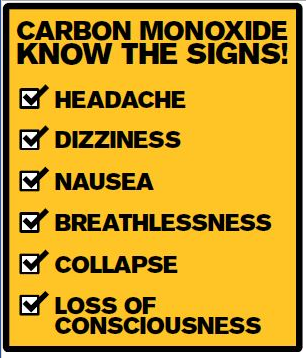

- #Carbon monoxide symptoms skin
- #Carbon monoxide symptoms portable
- #Carbon monoxide symptoms windows
There is no substitute for regular servicing of your gas/oil/coal burning appliances, but you should be on the lookout for: There are visible signs that your appliance is not functioning correctly, and could be producing toxic levels of CO/TC.

#Carbon monoxide symptoms skin
Rarely, a cherry red appearance to skin and lips. Bluish discoloration of the skin and nails. It's very important to be aware of the risk of carbon monoxide poisoning and to look out for warning signs.CO poisoning does have symptoms, but they mimic many common ailments and are easily be confused with flu or simple tiredness. Domestic gas installation and health and safety. seek medical help from a qualified healthcare professionalĬarbon monoxide poisoning can also cause long-term health problems if you’re exposed to low doses over a long period of time.Īppliances should not be used again until they have been serviced by a registered engineer. #Carbon monoxide symptoms windows
ventilate your home by opening windows and doors.immediately turn off all appliances if it is safe to do so.If you think you might be suffering from carbon monoxide poisoning, you should: It's important to be aware of the dangers and identify any appliances in your house that could potentially leak carbon monoxide. In very severe cases, it can result in death. Long periods of significant exposure to carbon monoxide can cause serious complications, including brain damage and heart problems. read more about gas safety and carbon monoxideĬomplications of carbon monoxide poisoning.

Your house will also need to be checked for safety before anyone returns. Go immediately to your local emergency department if you think you or someone with you has been exposed to carbon monoxide and the symptoms suggest high levels (see above). Seek medical advice from your GP if you think you've been exposed to low levels of carbon monoxide.
#Carbon monoxide symptoms portable
The risk of exposure to carbon monoxide from portable devices may also be higher in caravans, boats and mobile homes. Incorrectly installed, poorly maintained or poorly ventilated household appliances – such as cookers, heaters and central heating boilers – are the most common causes of accidental exposure to carbon monoxide.
 loss of consciousness – in cases where there are very high levels of carbon monoxide, death may occur within minutesĬarbon monoxide is produced when fuels such as gas, oil, coal and wood don't burn fully.īurning charcoal, running cars and the smoke from cigarettes also produce carbon monoxide gas. seizures – an uncontrollable burst of electrical activity in the brain that causes muscle spasms. chest pain caused by angina or a heart attack. breathlessness and tachycardia (a heart rate of more than 100 beats per minute). ataxia – loss of physical co-ordination caused by underlying damage to the brain and nervous system. vertigo – the feeling that you or the environment around you is spinning. impaired mental state and personality changes (intoxication). The symptoms can gradually get worse with long periods of exposure to carbon monoxide, leading to a delay in diagnosis.īreathing in high levels of carbon monoxide gas can cause more severe symptoms. The symptoms of exposure to low levels of carbon monoxide can be similar to those of food poisoning and flu. But unlike flu, carbon monoxide poisoning doesn't cause a high temperature (fever). shortness of breath and difficulty breathing. The symptoms of carbon monoxide poisoning aren't always obvious, particularly during low-level exposure.Ī tension-type headache is the most common symptom of mild carbon monoxide poisoning. Other symptoms include: Go immediately to your local emergency department if you think you've been exposed to carbon monoxide and have symptoms (see below). It can kill if you're exposed to high levels. Carbon monoxide is a poisonous gas that has no smell or taste.
loss of consciousness – in cases where there are very high levels of carbon monoxide, death may occur within minutesĬarbon monoxide is produced when fuels such as gas, oil, coal and wood don't burn fully.īurning charcoal, running cars and the smoke from cigarettes also produce carbon monoxide gas. seizures – an uncontrollable burst of electrical activity in the brain that causes muscle spasms. chest pain caused by angina or a heart attack. breathlessness and tachycardia (a heart rate of more than 100 beats per minute). ataxia – loss of physical co-ordination caused by underlying damage to the brain and nervous system. vertigo – the feeling that you or the environment around you is spinning. impaired mental state and personality changes (intoxication). The symptoms can gradually get worse with long periods of exposure to carbon monoxide, leading to a delay in diagnosis.īreathing in high levels of carbon monoxide gas can cause more severe symptoms. The symptoms of exposure to low levels of carbon monoxide can be similar to those of food poisoning and flu. But unlike flu, carbon monoxide poisoning doesn't cause a high temperature (fever). shortness of breath and difficulty breathing. The symptoms of carbon monoxide poisoning aren't always obvious, particularly during low-level exposure.Ī tension-type headache is the most common symptom of mild carbon monoxide poisoning. Other symptoms include: Go immediately to your local emergency department if you think you've been exposed to carbon monoxide and have symptoms (see below). It can kill if you're exposed to high levels. Carbon monoxide is a poisonous gas that has no smell or taste.








 0 kommentar(er)
0 kommentar(er)
